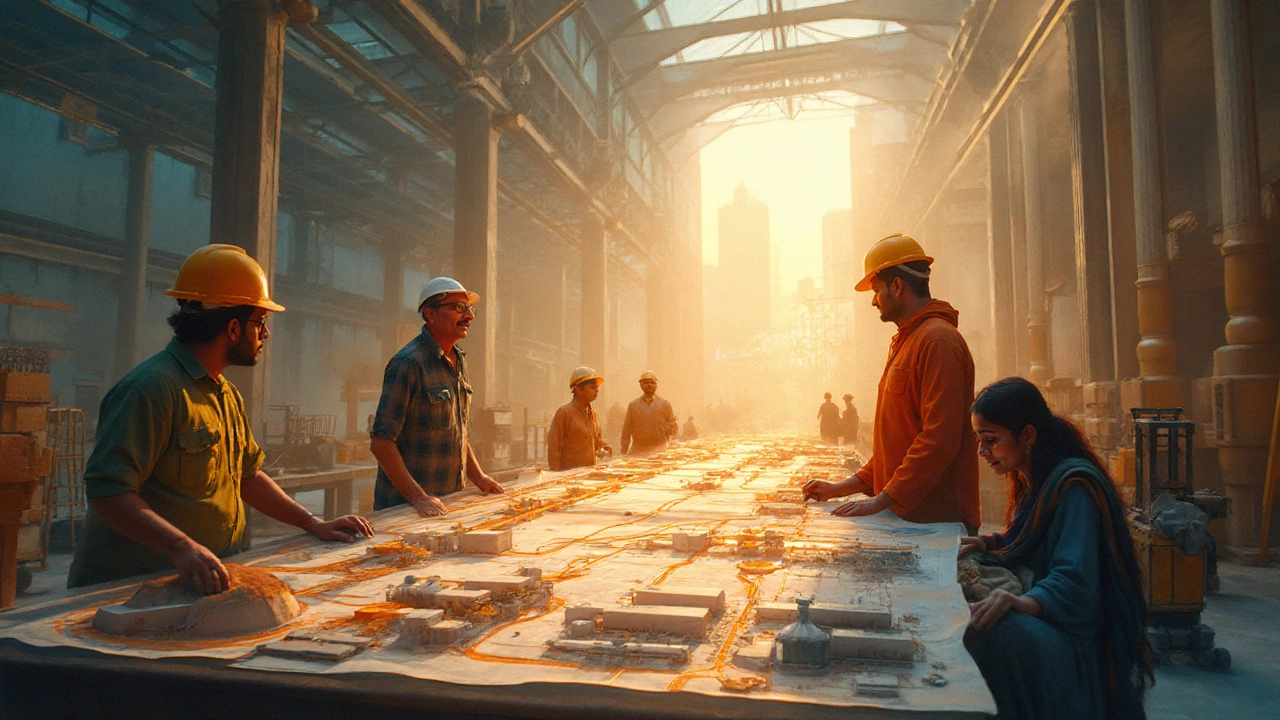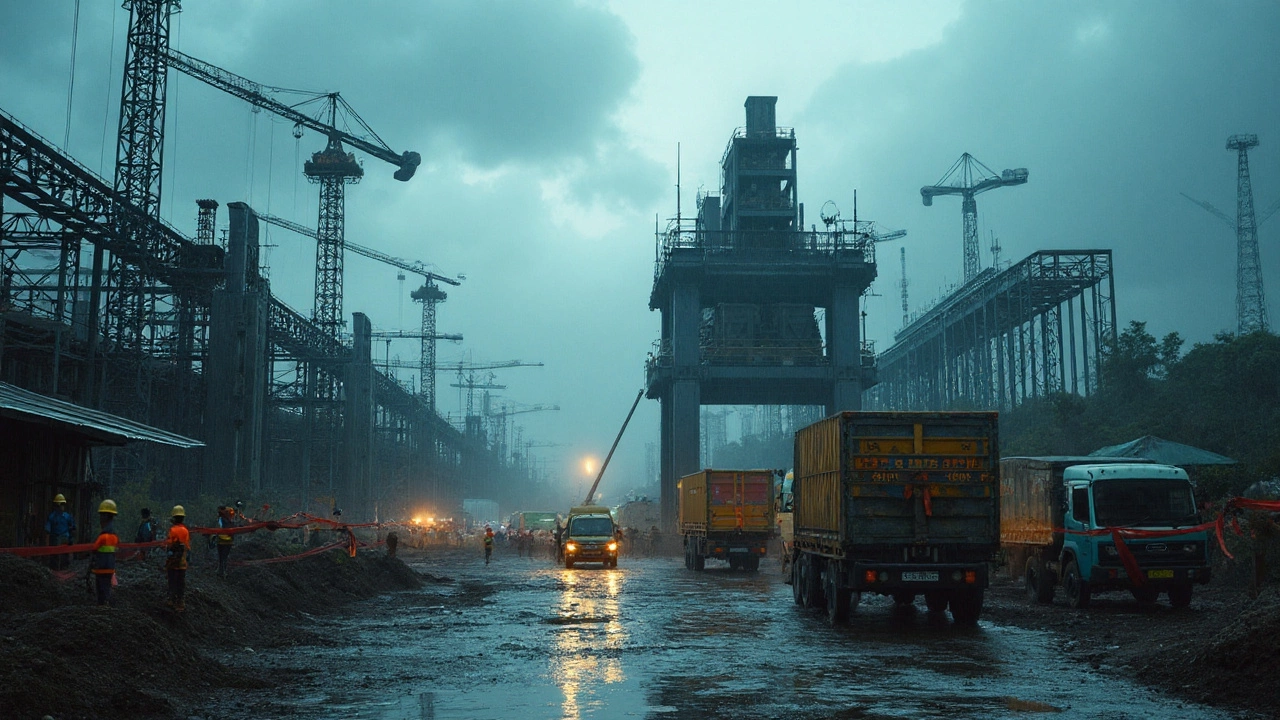You’ve heard the promise for a decade: India will become the world’s next factory. The target keeps shifting-25% of GDP by 2025, then 2030-but the needle barely moves. Manufacturing’s share has hovered in the mid-teens, jobs aren’t scaling fast enough, and many firms still fight high costs and policy whiplash. This isn’t about slogans; it’s about execution. If you’re trying to understand what’s blocking the flywheel-and what would actually get it spinning-here’s the plain, unvarnished picture of manufacturing in India today.
TL;DR: What’s really going on
- Costs and reliability: Power is pricey and uneven, logistics are improving but still slow, and land is hard to assemble. That kills margins before you even export a box.
- Policy mix: Production-linked incentives (PLI) helped specific plants, but tariffs, inverted duty structures, and uncertain rules cancel out some gains.
- Scale and skills: Big clusters are too few, mid-sized firms struggle to access credit and technology, and skilled shop-floor talent is patchy.
- Demand and trade: Domestic demand tilts to services; export competitiveness is held back by high input costs and limited FTA coverage.
- The fix: Get land-power-logistics predictable, cut effective protection where it hurts value-add, finance MSMEs at scale, push deep supply chain localization, and lock in “no-surprise” policy for a decade.
What’s actually holding back the factory surge
Let’s call out the blockers directly. No one of these is fatal. Together they slow everything down.
1) Cost stack: power, freight, compliance
Industrial power in India typically comes at 8-11 US cents/kWh for many buyers once cross-subsidy, demand charges, and captive backup are in. Vietnam’s comparable rates are often a notch lower with better reliability. Freight is cheaper than five years ago but still bites: road freight costs on busy routes remain higher than China’s per tonne-km, and port dwell times, while improving, still lag the best in class. Compliance costs (returns, inspections, certifications) eat small firms’ bandwidth.
2) Land and permits
Getting a clean, litigation-free parcel with utilities, effluent, and last-mile road can take months. States with ready plug-and-play parks (Gujarat, Tamil Nadu) move faster, but in many places, titles, clearances, and connections can drag. Speed matters-most investors won’t wait 12-18 months for basic utilities.
3) Tariffs and inverted duty
Raising customs duties on parts while keeping finished goods lower (or vice versa) distorts incentives. You get assembly with shallow value-add because upstream inputs are too expensive. This showed up in electronics, solar, and toys at different points. The moment your input bill runs hot, your export price loses its edge.
4) Policy volatility and trust
Investors like certainty more than subsidies. Mid-policy changes-sudden tariff moves, complex certification requirements, or shifting import rules-force CFOs into defensive mode. A predictable 5-10 year glide path often beats any one-time incentive.
5) Credit to the “missing middle”
Large firms can raise at fine rates; micro firms lean on informal credit. The “missing middle” struggles to secure affordable working capital and equipment finance. The MSME credit gap, estimated in the hundreds of billions of dollars by development finance institutions, keeps many capable suppliers from scaling and automating.
6) Skills and shop-floor capability
India produces engineers in bulk but not enough toolmakers, welders, machinists, and maintenance technicians. Apprenticeship pathways are widening but still thin relative to need. Quality systems, lean, and TPM adoption hit a ceiling in many tier-2 suppliers.
7) Fragmented clusters and weak local supply chains
Manufacturing scales in dense, well-served clusters with shared suppliers, testing labs, toolrooms, housing, and logistics. India has a few strong ones-Sriperumbudur (electronics/auto), Sanand (auto), Vapi-Ankleshwar (chemicals), Morbi (ceramics)-but we need dozens more at similar quality.
8) Trade posture and market access
India skipped RCEP, signed CEPA with UAE, an early deal with Australia, and an investment-heavy pact with EFTA. That’s progress, but exporters in electronics, autos, and textiles still face higher tariffs into key markets versus Vietnam or Mexico. The pipeline FTAs (like UK) are important to unlock scale.
9) Demand composition and the services tilt
India’s domestic market is large but uneven-high-end sells, but the mass market is price sensitive. A big share of consumer spend goes to services. Manufacturing thrives when exports fly and when domestic buyers push for quality and scale. Right now, exports are constrained by costs and market access.
10) Labor rules on paper vs. on ground
The new national labor codes aim to simplify, but state-level implementation is uneven. Without clear, stable rules on hiring, overtime, and contract labor, many plants stay smaller than they should. Scale economics never shows up.
Here’s a compact reality check against peers. It’s not doom. It’s a map of where to focus.
| Metric (latest available) | India | Vietnam | Bangladesh | China | Notes / Typical Sources |
|---|---|---|---|---|---|
| Manufacturing share of GDP | ~16-17% | ~24-25% | ~22% | ~26-28% | RBI/National Accounts, General Statistics Offices, 2023-2024 |
| Industrial power tariff (US cents/kWh) | ~8-11 | ~7-9 | ~9-10 | ~8-10 | Regulators/utility schedules, 2024 |
| Average port container dwell time | ~2-3 days | ~1-2 days | ~2-3 days | < 1-2 days | Port authorities/Customs, 2023-2024 |
| Logistics performance (rank) | Mid-tier | Upper mid-tier | Mid-tier | Top-tier | World Bank LPI 2023 |
| Female labor force participation | ~35-37% | ~47-50% | ~37-39% | ~60%+ | PLFS/ILO, 2023-2024 |
| Manufacturing FDI share | ~20-30% | High | Moderate | High | Central bank FDI data, 2022-2024 |
The data is directionally clear: India can compete, but to win consistently we have to shave costs, guarantee reliability, and get market access right.

What would actually move the needle in 3-5 years
There’s a practical path. It’s not glamorous, but it works. Think of it as a sequence, because doing step 5 before step 1 wastes money.
- Land first, then everything else: unlock plug-and-play parks
Set up fully permitted industrial parks with power, water, CETP/ZLD where needed, rail siding, and housing. Score states on “days to start production” and publish it. Heuristic: 90 days to land + utilities is the threshold most global OEMs use for greenfield decisions. - Power you can bank on: 24/7 at predictable tariffs
Allow open access and group captive more easily; reduce cross-subsidy on industrial tariffs while targeting direct benefits to households. Target 6-7 cents/kWh effective for large users, 8-9 cents for MSMEs, with guaranteed uptime. Enable simple PPAs for renewables + storage near clusters. - Freight: put a stopwatch on ports and a microscope on last-mile
Make 48-hour door-to-port a standard in top corridors; cut container dwell to under 36 hours at major ports. Fix the last 20 kilometers: wider gates, staggered slotting, truck parking, and EDI that actually updates in real time. Rule of thumb: every day saved at the port adds ~0.5-1% margin in time-sensitive exports. - Tariff reset and FTA focus
Clean up inverted duty structures in electronics, solar, toys, bicycles, and specialty chemicals. Pair this with FTAs that open big markets: UK/EU-type deals matter for autos, chemicals, and textiles. Aim for a stable, published 3-year tariff glide path so CFOs can price confidently. - PLI 2.0: from assembly to design, tooling, and deep localization
Keep incentives but tie them to value-add milestones: local toolrooms and dies, PCB fabrication, chemicals intermediates, and critical components. Avoid subsidizing only the final box; pay for the guts of the supply chain. - Finance the missing middle
Use GST and bank transaction data to underwrite MSME working capital automatically. Expand credit guarantee cover for machinery loans. Practical win: a 300-basis-point cheaper loan on a CNC or press line can shave unit costs by 2-3% once throughput rises. - Skills: apprenticeships at scale, not just classrooms
Make it easy for a 200-person factory to host 20 apprentices with simple stipends and light paperwork. Pay per skill demonstrated on the line, not just classroom hours. Tie incentives to pass rates on credible assessments (e.g., welding 6G, SMT rework standards, GD&T). - Labor codes: harmonize at the state level
If you want 1,000+ worker plants, you need clarity on hiring/firing thresholds, overtime, and contract staffing. Publish state-wise “single page” operational summaries and freeze them for 5 years. - Worker housing and transit
Dorms, buses, and creches near plants sound soft. They’re not. They reduce absenteeism, expand the talent pool (especially women), and raise retention. One-time CAPEX support for dorms near clusters pays back in 12-24 months through lower churn. - Regulatory “quiet period”
No surprise changes. Bundle updates into two predictable windows a year. If you must tighten a standard, give a 12-18 month runway and a clean checklist.
Two quick heuristics leaders use when sanity-checking a manufacturing bet:
- Total landed cost rule: Your post-incentive landed cost must beat the incumbent (often China/Vietnam) by 5-7% for sticky relocation. A tie is not enough.
- 3-30-300 rule: Under 3 months to start, under $30/MWh all-in power for large users, under 300 minutes average factory-to-port gate time in top corridors. Miss any of these, your odds drop.
Examples, benchmarks, and realistic pathways
Let’s talk specifics. Where India is winning-and where the gaps are obvious.
Mobiles and electronics (Tamil Nadu, UP, Karnataka)
Assembly lines scaled fast under PLI. India has become a major exporter of smartphones by volume. The challenge is value-add: the domestic content in many devices still sits around the high teens to low twenties for typical models. The next leap is substrates, precision mechanics, batteries, camera modules, PCBs at scale. That means toolrooms, plating, clean rooms, and chemical supply chains inside the cluster, not 5,000 km away.
Auto and components (Tamil Nadu, Maharashtra, Gujarat)
A bright spot. Strong OEMs, globally competitive suppliers, and rising exports in components. The opportunity now is powertrain transition (EVs and hybrids), lightweighting, and electronics. This needs specialized machinery finance and testing labs close to plants, plus standards alignment with export markets.
Chemicals and pharmaceuticals (Gujarat, Maharashtra, Telangana)
India is competitive in many specialty chemicals, supported by clusters like Vapi-Ankleshwar and Dahej. The constraints are environmental permits, effluent capacity, and reliable gas/power. When parks pre-invest in CETP and shared infrastructure, firms scale faster and face fewer compliance surprises.
Textiles and apparel (Tamil Nadu, Gujarat, parts of North India)
Bangladesh and Vietnam gained share on trade access and cost. India’s edge comes from integrated value chains (cotton to garment), technical textiles, and faster response. Lowering logistics friction and securing better trade terms can swing orders back, especially in man-made fiber segments.
Solar and renewables
Gigawatt-scale module capacity was built, but upstream-polysilicon, wafers-remains thin. Inverted duty episodes made planning hard. The fix is a stable tariff-cum-incentive framework tied to measured domestic value-add and quality benchmarks, not just nameplate capacity.
State competition matters. Tamil Nadu and Gujarat often win on readiness; Uttar Pradesh is moving fast on electronics; Karnataka pulls in precision manufacturing; Maharashtra wins on market access and talent. Publishing a hard-nosed state scorecard-time to power, cost to connect gas, port dwell times, legal dispute timelines-would sharpen this race.
For business owners thinking, “What can I do right now?” here’s a blunt checklist I use when advising mid-sized factories:
- Site selection pre-mortem: If a park can’t prove 24/7 power, water, effluent, and truck parking in writing, walk away.
- Energy cost hack: Compare three options: discom tariff, group captive, and a hybrid PPA (solar + firming). Pick the one that guarantees uptime and under 8-9 cents/kWh all-in for MSMEs.
- Throughput before robots: Don’t buy automation until takt time and layout are tight. Often, a U-shaped cell and better fixtures beat a fancy robot.
- Quality at source: Track first-pass yield and cost of poor quality daily. If FPY is under 95% in repetitive ops, fix that before chasing new customers.
- Supplier finance: Use GST data to negotiate better invoice discounting. A 1% cheaper working capital line can be the difference between profit and red ink on export orders.
- Freight speed: Push your forwarder for live EDI and a written dwell-time SLA. “We’ll try” is not a plan.
- Skill pipeline: Always be training. Ten apprentices every quarter beats one big recruitment day a year.
If you’re an investor, use a simple filter:
- Is the cluster deep? Count toolrooms, testing labs, plating shops, die-makers within 50 km. If you find none, factor in a 12-24 month delay and higher costs.
- Is the tariff path clear? If duties or standards are in flux, haircut your IRR by 200-300 bps or wait.
- Is the customer sticky? Look for multi-year contracts with penalty clauses for both sides. Transactional orders evaporate in downturns.

Quick answers, then your next steps
Doesn’t PLI solve growth?
PLI accelerated capacity in a few sectors and anchored global OEMs. But incentives can’t permanently offset high input costs, slow logistics, or policy surprises. Without deeper localization and easier operations, you get assembly-not a resilient ecosystem.
Is labor the main problem?
Not by itself. Wages in India are competitive. The real issue is stability, scale, and skills. When plants cross 1,000+ workers with clear rules and strong training, productivity jumps.
Will automation kill the job story?
Automation shifts jobs; it doesn’t erase them. You get fewer low-skill roles and more maintenance, quality, programming, and logistics jobs. The win is better wages per worker and higher export competitiveness.
Can India leapfrog to green manufacturing?
Yes, if we align cheap renewable PPAs, storage, and cleaner process tech with clear standards. Green steel, green ammonia, and renewable-heavy electronics assembly are realistic if power is reliable and certification is trusted by buyers.
What’s a realistic timeline?
If states deliver plug-and-play parks and tariff clarity within a year, you see order books shift within 12-24 months and deeper supply chains in 3-5 years. Big outcomes take compounding, not quarters.
Which sectors look strongest for 2025-2030?
Precision auto components, electronics (with deeper component focus), specialty chemicals, medical devices, and technical textiles. Each needs cluster depth and steady rules to truly scale.
What to watch as leading indicators
- Port dwell time trend at top five ports.
- State-level time-to-utilities dashboards.
- Credit growth to MSME manufacturing using GST-based underwriting.
- Domestic value-add percentages published by PLI beneficiaries.
- FTAs closed with the UK/EU and tariff glides published.
Next steps if you’re a policymaker
- Pick five sectors and five parks. Make them best-in-Asia on a stopwatch: 90-day go-live, 24/7 power, 36-hour port dwell.
- Publish a 3-year tariff and standardization roadmap. No mid-year surprises.
- Mandate an apprenticeship target per park with simple reimbursements tied to assessments.
- Turn on a portal for real-time utilities status per plot: power, water, gas, effluent capacity.
Next steps if you run a mid-sized factory
- Map your cost stack line by line: power, freight, scrap, rework, finance. Attack the top two relentlessly.
- Lock a hybrid energy deal; measure uptime weekly.
- Run a layout kaizen and raise first-pass yield above 98% in your bottleneck process.
- Pilot one export customer with a small, high-mix line to learn logistics and certification.
- Onboard 10 apprentices each quarter and assign a trainer with a clear KPI: deployable in 60 days.
Next steps if you’re a foreign OEM
- Choose a state with a live cluster in your supply chain. Verify utilities and supplier depth in person.
- Structure contracts to share currency and freight risk with Indian suppliers.
- Co-invest in a local toolroom or testing facility; it speeds up localization more than any grant.
If you’ve read this far, you know the story isn’t that India can’t build. It’s that manufacturing scales when boring basics are world-class. Get power, land, logistics, and rules right, and the rest-capital, skills, exports-follow faster than most people think.
Sources used for data points: Reserve Bank of India (Handbook of Statistics, 2024-2025), Periodic Labour Force Survey (2023-2024), World Bank Logistics Performance Index (2023), national port and customs statistics (2023-2024), CMIE capex indicators (2024), and official policy documents on PLI and FTAs. Figures are rounded and indicative.
